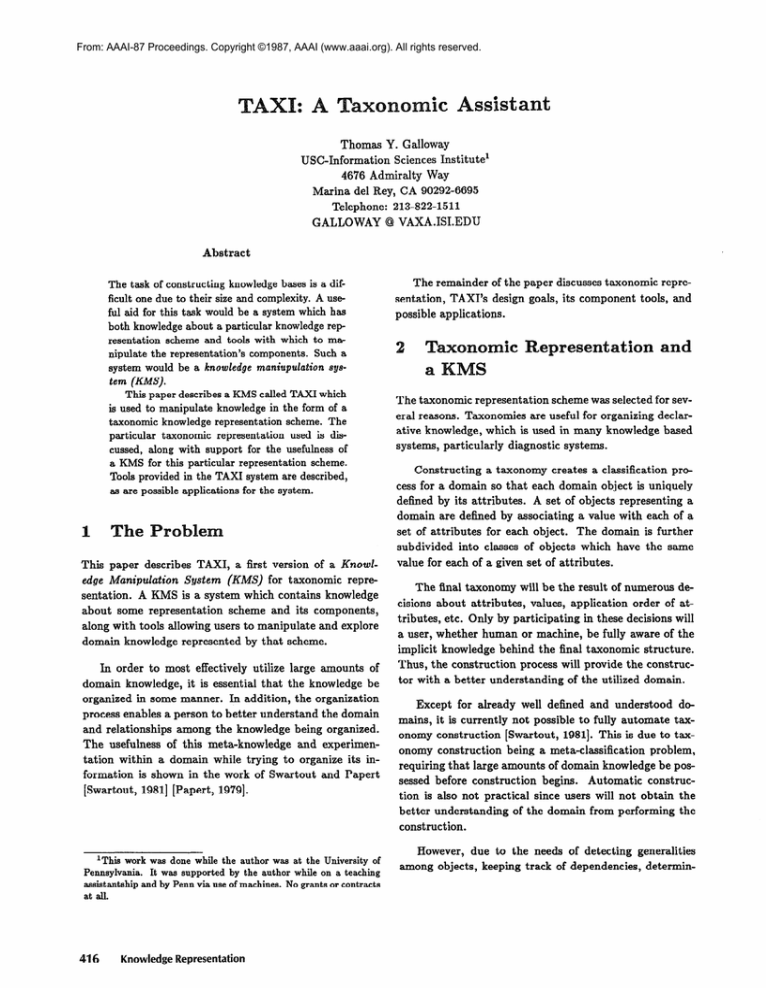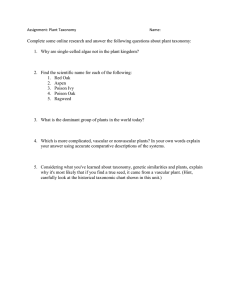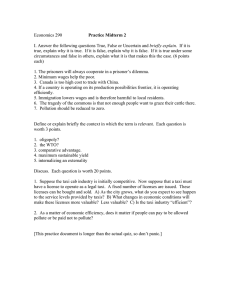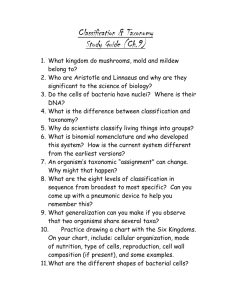
From: AAAI-87 Proceedings. Copyright ©1987, AAAI (www.aaai.org). All rights reserved.
Thomas Y. Galloway
USC-Information Sciences Institute1
4676 Admiralty Way
Marina de1 Key, CA 90292-6695
Telephone: 213-822-1511
GALLC WAY @ VAXA.ISI.EDU
Abstract
The task of constructing knowledge bases is a difficult one due to their size and complexity. A useful aid for this task would be a system which has
both knowledge about a particular knowledge representation scheme and tools with which to manipulate the representation’s components. Such a
system would be a knowledge maniupulation
systern (KMS).
This paper describes a KMS called TAXI which
is used to manipulate knowledge in the form of a
taxonomic knowledge representation scheme. The
particular taxonomic representation used is discussed, along with support for the usefulness of
a KMS for this particular representation scheme.
Tools provided in the TAXI system are described,
as are possible applications for the system.
Thii paper describes TAXI,
a first version of a Knowlfor taxonomic representation. A KMS is a system which contains knowledge
about some representation scheme and its components,
edge Manipulation
System
(KM!?)
along with tools allowing users to manipulate and explore
domain knowledge represented by that scheme.
In order to most effectively utilize large amounts of
domain knowledge, it is essential that the knowledge be
organized in some manner. In addition, the organization
process enables a person to better understand the domain
and relationships among the knowledge being organized.
The usefulness of this meta-knowledge and experimentation within a domain while trying to organize its information is shown in the work of Swartout and Papert
[Swartout, 19811 [Papert, 19791.
lThis work was done while the author was at the University of
Pennsylvania. It was supported by the author while on a teaching
amistantship aud by Penn via use of machines. No grants or contracts
at all.
416
Knowledge Representation
The remainder of the paper discusses taxonomic representation, TAXI’s design goals, its component tools, and
possible applications.
The taxonomic representation scheme was selected for severa1 reasons.
Taxonornies
are useful for organizing
declar-
ative knowledge, which is used in many knowledge based
systems, particularly diagnostic systems.
Constructing a taxonomy creates a classification process for a domain so that each domain object is uniquely
defined by its attributes. A set of objects representing a
domain are defined by associating a value with each of a
set of attributes for each object. The domain is further
subdivided into classes of objects which have the same
value for each of a given set of attributes.
The final taxonomy will be the result of numerous decisions about attributes, values, application order of attributes, etc. Only by participating in these decisions will
a user, whether human or machine, be fully aware of the
implicit knowledge behind the final taxonomic structure.
Thus, the construction process will provide the constructor with a better understanding of the utilized domain.
Except for already well defined and understood domains, it is currently not possible to fully automate taxonomy construction [Swartout, 19811. This is due to taxonomy construction being a meta-classification problem,
requiring that large amounts of domain knowledge be possessed before construction begins. Automatic construction is also not practical since users will not obtain the
better understanding of the domain from performing the
construction.
However, due to the needs of detecting generalities
among objects, keeping track of dependencies, determin-
ing useful classification attributes, and constantly reforming the taxonomy, large taxonomies are difficult for people
to construct.
Thus, the hybrid approach of a KMS, used as a taxonomic assistant in this case, appears appropriate. A person can contribute the domain knowledge and control the
construction process while the assistant can keep track of
dependencies, perform the grunge work of bookkeeping,
and detect generalities in the knowledge uncovered by use
of the taxonomic representation. Taxonomy construction
is thus easier, more efficient, and allows for more experimentation during the design phase. Taxonomy editing,
which is required unless dealing with a static domain, will
also be easier.
Finally, a taxonomic KMS is useful for learning about
a domain. By using the provided tools to alter the structure of an existing taxonomy, users can examine a domain
from many perspectives, discovering the consequences of
different classifications and obtaining a better understanding of how objects and classes are interrelated than can
be obtained via a static taxonomy such as the biological
taxonomy used in schools.
epresentation
theme
Taxonomies can be represented in several ways. For example, a powerful representation results from the use of
a directed acyclic graph or lattice as the base data structure. This representation allows nodes to have several
direct subsumers, and is used by the KL-ONE and NIKL
representation languages [Bra&man, 19851.
A simpler data structure for taxonomic representation
is the discrimination tree; a set of nodes partiahy ordered
by a subsumption relation to form a tree structure. Each
node can have only one subsumer (parent). Attributes
and their values are used as discriminators to divide sets
of objects into subsets.
There are four reasons why TAXI uses the discrimination tree structure.
simplicity: For the first version of
a taxonomic assistant, it was desirable to have an
easily implemented representation. Many design decisions involving user interface design, tool selection, and which taxonomic components are important would be the same no matter what representation was used.
Conceptual simplicity: Among other aims, TAXI is
intended to be used as a learning tool. The discrimination tree representation is easier to comprehend for most users, making it easier to perceive
taxonomy component interrelationships and dependencies.
Familiarity: Many people are already familiar with
the discrimination tree structure from their exposure to the biological taxonomy in school, and thus
will already understand the underlying data structure. Having to explain a more complex representation scheme to a user will serve as one more obstacle
to system use.
. Graphical representation:
Discrimination trees are
simple to represent graphically. A graphic based
user interface is important because it conveys information in a direct and easily understood manner.
Using a discrimination tree, most users already possess the intuitive understanding that objects/&sees
which are close together are relatively similar, and
that the further down a tree a class is, the less general it is.
TAXI’s design paradigm is similar to a good text editor’s, It contains knowledge about discrimination tree
structure, taxonomy components, their interrelationships
and dependencies, and tools for structure and domain manipulation.
The final result of a taxonomy construction should be a
tree where each object in the domain set occupies a unique
leaf node. Objects are distinguished by defining them in
terms of attributes and associated values. Attributes are
used as discriminators at levels in the tree.
Taxonomy construction is essentially a trial and error
process, and is both incremental and non-modular. Decisions must be made as to which attributes are “best” for
the desired taxonomy, and in what order they are applied
as discriminators. In order to experiment with these decisions, the taxonomy must be reformed with each new
experiment. However, since TAXI automatically reforms
the taxonomy for users, experimentation is much easier.
1. Computational
TAXI possesses knowledge of six taxonomic components;
Objects, Attributes, Ii?$pes, Classes, Discriminators, and
the Tazonomgl itself. TAXI has tools for the creation and
editing of each component, as well as other tools for manipulating overall taxonomic structure and interrelationships. While individual tools are not very powerful, the
Galloway
417
entire set (currently about 40) provides users with control
over the construction, editing, exploration, and experimental processes for discrimination tree taxonomies. In
this section, I discuss the structure of a TAXI taxonomy,
and some of the more powerful and useful tools.
A taxonomy’s initial state is a single class, containing
all domain objects, which is the root of the tree. This
inital class/node is divided into subclasses which are the
nodes at the next tree level of the tree by selecting an
attribute and creating a subclass for each possible value
of the attribute. In the case of attributes which can have
an large, or even infinite number of possible values (ones
which take numeric values, for example), the subclasses
are limited to values currently used in the taxonomy’s
objects.
Objects consist of a name and a definition. The definition is the set of defined attributes and their values
for that object. Classes contain objects as members, and
are defined as the set of attributes and associated values
which are the same for all members.
Attributes and their values define classes and objects.
For computational efficiency and to let users easily determine possible values, each attribute has a type which
defines all the possible values for the attribute. Types can
be associated with more than one attribute.
Untyped attributes have been suggested due to difficulty in anticipating all possible values when initially
defining an attribute [Silverman, 19841. However, TAXI
provides a tool to easily edit type definitions. The usefulness of types for formalization of attribute definitions and
detection of invalid values overcomes the minor inconvenience of editing or examining a type definition.
TAXI currently has two meta-types, numeric and nonof which all types are one or the other. Nonnumeric types may contain numeric values, but numeric
types can only contain numbers.
numeric,
Meta-types exist only for implementation reasons. It
is difficult to represent in a menu infinite or very large
numbers of possible values, such as are possible for attributes which possess numeric values. By limiting the
possible values for an attribute to numbers, it is possible
to ask the user to merely type in a number when assigning
a value, as opposed to trying to display an infinite number
of possible values in a menu. Numeric types may be restricted to allow values only between user-defined ranges;
for example a type might allow only values between 1 and
100 as well as between 3000 and 4000.
41%
Knowledge Representation
Types automatically have *NONE* included as one of
their values. *NONE* is used when an attribute is not applicable to an object, such as the attribute hair-color for
the object Yul-Brenszer. Of course, TAXI has knowledge
about the meaning of the *NONE* value. The current
implementation of TAXI requires that every object in the
taxonomy have a value for each attribute used as a discriminator in the tree structure.
Changes to type definitions can have large impacts on
taxonomies.
For example, if a value is deleted from a
type, all objects with that value for an attribute of that
type will be affected, as will all classes based on that attribute/value. Users are prompted for a new value for each
instance of an affected attribute, and affected objects are
automatically reclassified.
If a type is deleted, the effects can propagate. Users
are asked whether to also delete the attributes of that
type, and if not, to provide a new type(s). This will further affect the taxonomy, as discussed later.
Types can be defined using other types by taking a
subset of values from an existing type, or via an intersection or union operation on a set of existing types. New
values can be added to the result of these methods as well.
Types are assigned during attribute definition. A new
type may be declared when the first attribute of the type
is declared. Immediately after an attribute is declared,
users are queried about the attribute’s value for each existing object. The attribute/value is incorporated into the
existing object definitions.
When a new attribute is defined, users are asked if
it should be incorporated immediately into the taxonomy
as a discriminator. A user is free to decline. A list of
defined attributes which are not used as discriminators is
maintained by TAXI and can be examined at any time.
If an attribute is used in the taxonomy as a discriminator, changes to attribute values will cause TAXI to
automatically reclassify affected objects, which will alter
the membership of the appropriate classes.
Whether an attribute is used as a discriminator, and at
what position in the tree it is used, is usually left to users,
unless assistance is requested as discussed later. When an
attribute is used, the user must specify the level it is to
be used at in the tree. TAXI then splits all classes on the
chosen level into subclasses based on the member objects’
associated value for that attribute. The taxonomy is then
reformed by applying the discriminators used at levels below the newly added discriminator to these subclasses in
the same order in which they were previously applied.
The order in which attributes are used as discriminators determines whether objects will be contained in the
same class(es) at points other than at the top of the tree.
For example, if the objects man and ostrich are both in a
taxonomy, and the first discrimination is Number-of-Legs,
then they’ll be in the same class on level 2, while if the discrimination is Has-Feathers, they would not. Since ideally
each object in the taxonomy should be the sole class member in a leaf node of the tree, and since people intuitively
believe that the closer two discrimination tree nodes are
together, the more similar they are, the choice of what
order to apply discriminators can have have a large effect on how users will percieve the relative similarity of
represented objects.
Therefore, TAXI allows users to change the level at
which an attribute is used as a discriminator. By altering the discriminator levels, users can observe taxonomies
from several perspectives and notice which objects tend to
share class membership (or which don’t), learning which
objects are relatively similar.
Since attributes define objects and classes, their selection is important. TAXI provides a tool for attribute
selection called Attribute Aid based on Personal Construct
Theory [Boose, 19841. Attribute Aid attempts to encourages users to consider small subsets of the object set. In
one form, users are presented with a randomly selected set
of three objects on which Attribute Aid has not been previously used. They are then asked to define an attribute
which would distinguish one object from the others; one of
the objects would have a different value for that attribute
than the other two. By remaining in Attribute Aid, such
an attribute can be determined for every object. It is
also possible to continue the process until all objects are
uniquely defined, and as such are all represented as the
sole member of a class which is a terminal node in the
discrimination tree.
Attribute Aid can also present users with a class consisting of more than one object which is a leaf node in the
tree. In other words, a class consisting of objects which
have yet to be uniquely defined. Until all objects in the
class are so distinguished,. Attribute Aid will query the
user for an attibute which will distinguish an object from
the other members of that class.
TAXI can also suggest a “best” attribute for a level.
Users may request either an euen or skewed distribution
for the next level. For even distribution, TAXI determines
which attribute which has not been used above that level
as a discriminator will cause the least standard deviation
among subclass size if so used. For skewed, TAXI finds
the attribute which would produce the largest standard
deviation. Even distributions create relatively balanced
trees, while skewed distributions are a quick method to
cause singular terminal nodes to form quickly, but which
form an unbalanced tree.
TAXI also allows users to begin with a set of objects,
and then order TAXI to continue to find either even or
skewed discriminations until either all objects are uniquely
defined, or all attributes have been used as discriminators.
It is also possible to define dependencies among objects
or attributes such that changes to the definition of one will
affect the definition of the other. Users are informed of
such changes, although they occur automatically.
The preceding has been an abbreviated description of
some of the tools provided by TAXI for manipulation of
the taxonomic structure supplied by a discrimination tree.
While each tool’s power is limited, the combined power of
the entire set allows users to quickly and easily construct,
modify, or experiment with a taxonomy represented in the
form of a discrimination tree.
TAXI’s research goals were to design and build a knowledge manipulation system which could &ve as a taxonomic assistant 0 The system would heI; users increase
their knowledge about a domain by enabling them to manipulate elements of the taxonomic representation, in addition to assisting in the.t&xonomic construction process.
In this section of the paper, we discuss possible applications for a taxonomic assistant.
TAXI has several practical applications. The most obvious would be for it to be used as a tool in the construction or reformulation of large taxonomies. One such area
in which it would be quite useful would be the current effort to redefine the biological taxonomy in terms of genetic
material and differences [Francis, 19851.
TAXI could also be used to determine previously unrealized similarities between objects in a domain. This
information could then be incorporated into knowledgebased diagnostic systems for the domain. For example, a
taxonomy of the intended domain for a diagnostic system
could be constructed using TAXI. Then, by reforming the
taxonomy by using different orderings or combinations of
attributes, those diseases which are often located close together in the taxonomy are those which are likely to be
confused with each other. A knowledge engineer could
incorporate this information in the system in the form of
special procedures for distinguishing between the discovered similar cases.
Galloway
419
Finally, TAXI’s exploratory tools could improve
knowledge engineers’ domain understanding. A domain
expert could use TAXI to create a taxonomy of various
domain concepts. A knowledge engineer could then use
TAXI’s tools to examine, explore, and play with that taxonomy, enabling him/her to obtain a better intuitive understanding of the domain and how its objects interact
before beginning work of the knowledge-based system.
2. Brachman, R.,
On the Epistemological
Status
of Semantic
Net-
works, in Readings in Knowledge Regresentation, Brachman R. & Levesque H. (eds), Morgan
Kaufman Publishing Company, 1985.
3. Francis, K.,
Personal communication,
1985.
4. Papert, S.,
Mindstorms,
6
TAXI is a first version taxonomy assistant/KM% There
are several improvements planned for future versions, including the removal of the Numeric/Non-Numeric
type
distinction, the ability to compare two similar taxonomies,
the ability to define and explore taxonomies for domain
subsets in depth and then incorporate findings into the
main taxonomy, and many other relatively minor refinements to TAXI’s tools.
Most importantly, a second generation TAXI should
be able to handle more sophisticated representation
schemes such as the ML-ONE representation and an extended discrimination tree which allows objects to have
multiple values for its attributes.
7
Conclusion
This paper has described TAXI, a knowledge manipulation system for taxonomic knowledge representations
which use a discrimination tree as their data structure.
TAXI’s KMS paradigm appears successful in allowing
users to obtain the benefits of constructing a taxonomy
without having to deal with many of the difficulties inherent to the task which are irrelevant to the goals of
constructing a usable taxonomy, or obtaining a better understanding of the domain. It is also successful in allowing users to experiment with taxonomies, allowing them
to view domain knowledge from several perspectives by
means of altering the definitions of objects and classes.
It is hoped that TAXI will prove to be of use to knowledge engineers, biologists, and perhaps most importantly,
to students seeking to improve their understanding of various domains.
8
References
1. Boose, J.,
Personal
Human
Construct
Ezpertise,
Theory
AAAI
1984.
420
Knowledge Representation
and the
Transfer
of
Conference Proceedings,
Houghton-Mifflen,
1979.
5. Silverman, D.,
An
Interactive,
6.
Classifier, Technical
University of Pennsylvania,
Incremental
Report MS-CIS-84-19,
1984.
Swartout WV.,
Explaining
and Justifying
Expert
Consulting
grams, IJCAI Conference Proceedings, 1981.
Pro-







